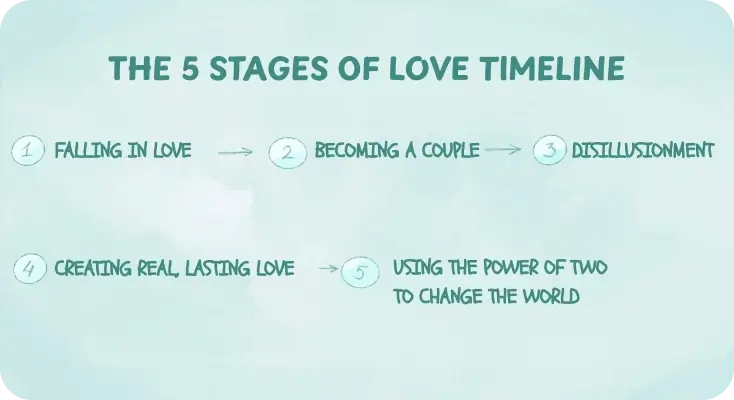You fall in love with someone, and it feels like something unbelievable. You seem to understand each other without words, have a deep emotional connection, and want to spend a lifetime together. And then reality hits.
Constant arguments and misunderstandings make you think that your couple has lost that initial spark. But is it really so? Quite often, no. It might be just the next stage of building and deepening relationships that most couples face.
In this article, we’ll look at the most common theories about the stages of love and how your connection might change over time. Keep reading to understand what’s typical, how to deal with problems, and how love can grow stronger, even when things feel hard.
Do you want to find out how you show love and affection, and what makes you feel most loved in return?
Take our quick test to learn more about yourself and your relationship patterns.
How many stages of love are there?
There’s no one universal or scientifically approved theory that identifies how most people get closer to their partners. Yet, two models are widely accepted in pop culture. We’ll focus on them below.
5 stages of love
This concept is mostly based on Dr. Jed Diamond’s works, particularly the book “The Enlightened Marriage: The 5 Transformative Stages of Relationships and Why the Best Is Still to Come.” The model is often used in popular psychology and in self-help content because it helps people understand that challenges in love are not signs of failure — they’re part of growth. The stages of love described by Dr. Jed Diamond include:
- Falling in love
- Becoming a couple
- Disillusionment
- Creating real, lasting love
- Using the power of two to change the world
We’ll describe each stage in detail in the next section. Yet, there’s one more quite popular model.
7 stages of love
Despite its apparent similarities, this framework originates from distinct sources. The 7 stages of love model blends concepts from Western psychology with insights from Eastern philosophy, especially Sufi and Vedic traditions, and ancient literature.
All these models describe love in different ways — some focus more on emotional development, while others lean into the spiritual or even poetic side of relationships. So we’ve gathered the most applicable and relatable ideas from each to give you a fuller picture of how love can grow, evolve, and deepen over time.
- Infatuation
- Discovery
- Monogamy
- Conflict
- Growth and stability
- Mature love
- Crisis and recovery
Now, let’s turn to both models and analyze how couples may proceed at any stage. Share this article with your partner to be ready to face the challenges and celebrate common wins.
The 5 stages of love in a relationship
Researchers found that almost 50 percent of all marriages in the United States will end in divorce or separation. [1] Of course, many factors influence divorce. Still, one of the reasons couples may break up or even divorce is because they can’t handle the “turbulent” phases of relationships. So, here are quick yet helpful insights that will let you process emotional wounds much more easily.
1. Falling in love (initial attraction, the honeymoon, or romantic love stage)
The first stage of love happens when you get interested in a potential partner. It’s also called a honeymoon phase because everything seems so bright and perfect. You start dating, experience sexual excitement, feel emotionally high, and often idealize your partner — seeing only the best in them.
Sometimes, this stage is also called ‘infatuation’ — strong but not usually lasting feelings of love or attraction. [2] This means that it might potentially lead to long-term commitment or, vice versa, end just as quickly as it began if deeper emotional bonds don’t form.
One more important aspect of the first stage is the fact that people idealize their partners. This might happen because of the changes in dopamine levels and other hormones (cortisol, oxytocin, and vasopressin) in your body. [3]
In a nutshell, when we fall in love, our brain gets flooded with “feel-good” chemicals that heighten attraction, reduce critical thinking, and create a feeling of euphoria. It makes it easier to overlook red flags in the early days of a relationship.
2. Becoming a couple
While the honeymoon stage is about passion, deep interest, and excitement, this stage is where bonding begins. You start building a shared life, creating routines together, and forming a sense of “us” instead of just “me and you.”
Partners may start living together, get married, or even have kids at this stage. They try to build a shared future, find likeminded friends, and lifestyles. It’s a time of growing closer through shared experiences, as well as feeling safe, appreciated and protected.
3. Disillusionment stage
Like all things, euphoria can’t last forever. Your idealized view of your partner may start to fade as your relationship progresses, and you start to see them for who they really are. It’s the third stage where couples may break up because of the inability to accept each other’s flaws, habits, and oddities.
Moreover, at this stage, partners may see only differences, which might make them feel disappointed and angry at each other. Of course, conflicts can follow this mix as well. One day, you may find yourself asking, “Why does my husband yell at me?”
Why is it so? Hormonal levels stabilize, and the brain is no longer under the intense influence of dopamine and other “love drugs.” As such, you stay on different pages and may even try to change each other to become a person ‘you originally started to date with.’
Yet, the main purpose of this stage is to learn to maintain your independence within the relationship without damaging the loving connection you’ve both put so much effort into creating. Here’s how to proceed with negative emotions:
- Pause before reacting. When you’re too emotional, take a moment to breathe and reflect before responding. This will let you avoid saying things you might regret.
- Use “I” statements. Instead of blaming your partner (“You never listen”), express how you feel (“I feel unheard when I’m interrupted”).
- Set boundaries. It’s OK to get closer at your own pace. You may need time alone or space for your own interests. For that, communicate your needs clearly.
- Don’t confuse closeness with control. You can love deeply without needing to monitor, fix, or micromanage your partner. True connection develops when both people feel free.
4. Creating real, lasting love (commitment stage)
The fourth stage comes when you learn to accept each other and appreciate your partner as a different person — with their flaws and imperfections. At the same time, this is where true emotional intimacy typically emerges.
It might feel like romantic love has come back, but now on a deeper level. Moreover, this is when you’re ready to truly support each other. Ideally, partners no longer want to change each other, but accept each other for who they are. There’s more trust, respect, and understanding, and both feel secure in the relationship.
5. Using the power of two to change the world (co-creation & partnership stage)
Finally, your relationship makes you feel so empowered and mature that you want to start giving back to your social life. You’ve already worked through the issues, accept each other, and have a “peaceful place” inside your couple. And you feel inspired to do more. In the fifth stage, people may:
- Start a business or creative project together
- Do volunteer work as a couple
- Mentor other couples
- Concentrate on parenting as a joint mission
- Travel to learn, grow, and connect with others
- Invest in shared dreams
Here, your partner feels like your best friend, a team member, and the one you trust most. You may want to spend all your future life hand-in-hand with this person.

The 7 stages of love — an alternative model
This is another model that may resonate with your relationship. It shares some similarities with Dr. Jed Diamond’s model and introduces some key differences.
1. Infatuation stage
This first stage is pretty similar to “falling in love” stage. In this phase, you experience intense attraction, passion, and butterflies. You feel attracted to each other physically and emotionally, but it’s still surface-level. This is typically followed by late-night texts, constant excitement to see each other, and a rush of emotions that makes everything feel magical — even if you don’t fully know the person yet.
2. Discovery stage
The second stage involves the feeling that reality starts to set in. Like the disillusionment stage, you start noticing the first flaws, get irritated at your partner, may want to spend more time alone, and maybe even think about how to break up with them. The masks come off, and if a couple wants to save their relationship, it requires a lot of diligent conversation, patience, and appreciation.
3. Monogamy stage
Intrusive thinking about your partner’s imperfections no longer bothers you so much, and you decide to preserve and honor the relationship. There’s less drama, more trust, and a calm sense of connection. The focus shifts from “me” to “we.” You start to spend time together more often and realize that love feels more calm and secure.
4. Conflict stage
While the previous stage might feel like the sun after the storm, this one is more like unexpected clouds rolling in. Old issues resurface, new conflicts emerge, and both partners may feel challenged by differences in values, habits, or communication styles. Staying committed might be challenging, and some partners might subconsciously try to fight for autonomy this way (especially if they live with insecure attachment styles).
5. Growth and stability stage
The beginning stages might feel really chaotic, but finally, they turn into a choice-based love. Problems stay in the past, and you discuss your life aspirations, set new priorities, and realize what matters most. Some couples might set shared goals here and build long-term plans that they may turn into reality in the later stages. This is where true emotional intimacy deepens.
6. Mature love stage
Studies prove that a relationship through which the partners can develop their potential, achieve personal and shared goals, and maintain a secure attachment can be highly beneficial for their well-being. [4] Typically, people reach this emotional depth and commitment at this stage.
It can also be called a Renaissance of romantic love. Partners experience heightened physical attraction, spend time together to reach common objectives, and provide each other with feelings of support and mutual respect. Now, you are partners in life, not just lovers.
7. Crisis and recovery stage
Lastly, at some point in life, couples may go through crisis-like situations. This might be something happening inside the relationship or an important change out of it. Some examples might include:
- Serious unresolved conflict
- Addiction or mental health issues of one partner
- Loss of trust due to dishonesty
- Death of a family member
- Job loss
- Fertility issues
- Major immigration stress, etc.
If all the initial stages were passed succesfully, a couple may have enough power and support to survive the storm and come out even stronger. It will likely require a lot of talking, trust, and commitment. Yet, after overcoming the challenges, the bond deepens and love evolves into true partnership.
Common relationship pitfalls by stage
No one stage is perfect but you can do it so particularly for your couple. By understanding common problems and pitfalls at each stage, you can work through them together and build a stronger connection.
1. The honeymoon stage:
- idealization of a person you’re in love with
- ignoring significant differences and red flags
- inexperience with communication on important topics
2. Becoming a couple
- challenges with balancing self-care and autonomy
- misunderstanding of expectations in the relationship
- difficulty in compromising
3. Disillusionment stage
- avoiding conflicts
- blaming each other for differences
- unrealistic expectations that cause disappointment
4. Commitment stage
- taking each other for granted
- limited or no talking on deep topics
- neglecting emotional intimacy
5. Co-creation & partnership stage
- accepting your couple as friends, not as lovers
- losing individuality in the relationship
- overlooking each other’s emotional needs

How therapy can help at any stage
Couples therapy is a powerful experience that can help you build deep trust, overcome challenges, and improve understanding. When talking to each other doesn’t help anymore or makes things worse, a licensed professional may guide the conversation to make it safe and productive.
Understand your love languages
When you first start falling in love or entering a relationship, your feelings may seem effortless and intense. However, over time, the way you give and receive love might differ from your partner’s, which can lead to conflicts.
You can take a quick & free love languages test in the Breeze app and get personalized insights on your approach to love. Yet, if nothing seems to help, a mental health professional can guide you through these differences.
Discuss challenges in a safe space
When angry or irritated, some people may turn to neglect and offensive words. If you don’t want it to happen or feel like you’re on the edge to say or do something you’ll regret, therapy offers a safe space to pause and reflect. Moreover, a professional will help you express your thoughts and understand triggers underlying certain reactions.
Build communication skills
Effective communication with a person you love is vital at any point. If you find it challenging to express your emotions and needs, couples therapy can teach you how to speak clearly and listen with empathy. Fostering emotional intimacy is another great outcome of learning to communicate openly without fear of judgment or rejection.
The male intimacy cycle
Information in this section is provided based on the Rubber Band Theory introduced by Dr. John Gray. It’s essential to note that there is no precise scientific research proving this theory. Instead, some of its aspects are based on attachment theory (especially the fact that men exhibit higher attachment avoidance [5]), gender socialization, and emotional regulation in men.
The Rubber Band Theory says that men in relationships often move between wanting closeness and needing space. After feeling very connected, they may pull away for a while to feel independent again. This doesn’t mean they’ve lost interest — it’s just how they recharge emotionally. So, here are 4 main stages in such a cycle.
1. Connection
This is the first stage when the physical attraction is high, and men experience both lust and emotional engagement. They want to be close and connected and crave attention, affection, and closeness from their partner.
2. Vulnerability
The next stage is vulnerability — something that man may find challenging to tolerate and experience. They might feel like something threatens them and — consciously or unconsciously — take a step back. Men may need a moment to process the fact that commitment isn’t equal to losing freedom.
3. Withdrawal
As such, to cope with this discomfort, men withdraw — emotionally, physically, or both. Some women can hold the idea that withdrawal means a lack of love or interest, but for men, it’s often a way to regain balance, have some rest, and process their emotions in a way that feels safe to them.
4. Reconnection
After some time, men tend to feel safe again, and their passion gets back. They may initiate sex, suggest spending time together, or just act more relaxed. This cycle may start over and over as men fluctuate between the desire for closeness and the need for space.
“If men are building serious and committed relationships, can they do something to avoid getting into the cycle in your opinion? If not, will it still be noticeable as in the first stages?” Nicole Arzt, LMFT, answers, “At all stages, it’s important for men to be mindful of their needs and feelings. Vulnerability can be scary, but it’s the bonding glue that keeps relationships feeling secure. Withdrawal can lead to confusion, loneliness, and resentment. If this is how you cope with stress, it may be helpful to actively try to work on this specific pattern. Doing so may benefit both your emotional well-being and your partner’s happiness.”
Conclusion
Whether you’re only falling for a person or keep dating for many years, there are always ways to make your relationship more compassionate and fulfilling. The Breeze app is a perfect tool for couples that can provide a lot of insights to bring you closer.
Take personality tests together and learn more about your similarities and differences. Track your mood and analyze what might trigger conflicts inside the relationship. Finally, build a common routine thanks to Breeze’s routine tracker and improve both emotional and physical well-being together.
FAQ
How long does each stage of love last?
There are no clear timelines when initial lust turns into long-term affection. In every couple, the terms might be pretty different. Yet, below we’ll provide very approximate timeframes based on common relationship patterns to give you a general idea of what to expect.
- Honeymoon stage (a few months to 2 years, based on hormonal changes [6])
- Becoming a couple (1 to 3 years)
- Disillusionment (can begin anytime after year 2 and last months to years)
- Commitment stage (may begin around years 4-6)
- Co-creation & partnership stage (about 7+ years)
Can you go back to the initial stages?
It highly depends on the relationship dynamic. For instance, you can experience the lust and passion that you had when you were only falling for a person. Even if you’re in disillusionment now, it doesn’t mean the spark is gone for good. With some effort and honest talks, you can bring back the passion — just in a deeper, more real way. It might not be exactly like the beginning, but it can still be strong and special.
Do all couples go through the same stages?
All relationships are different. You and the person you’re in love with can create your own story and move through the stages in your own unique way. For example, some relationships can need more time in certain phases, skip others, or circle back. What matters most is how you grow together, not how closely you follow the “typical” path.
Can love skip stages?
Here’s a comment from Nicole Arzt, LMFT, “All relationships are unique, and life does not occur in arbitrary phases. For example, some couples move straight from the honeymoon stage to the commitment stage. They may not have a choice (i.e. getting pregnant unexpectedly or experiencing a significant crisis together). Relationships move in and out of different phases based on what each partner (or the couple as a whole) undergoes.”
Sources
- Wilkinson & Finkbeiner. “Divorce Statistics: Over 115 Studies, Facts and Rates for 2024”
- Definition of infatuation from the Cambridge Advanced Learner’s Dictionary & Thesaurus © Cambridge University Press
- Richard Schwartz, Jacqueline Olds. “Love and the Brain.” 2015
- Gómez-López M, Viejo C, Ortega-Ruiz R. Well-Being and Romantic Relationships: A Systematic Review in Adolescence and Emerging Adulthood. Int J Environ Res Public Health. 2019
- Weber R, Eggenberger L, Stosch C, Walther A. Gender Differences in Attachment Anxiety and Avoidance and Their Association with Psychotherapy Use-Examining Students from a German University. Behav Sci (Basel). 2022
- London Doctor Clinic. “HOW DOES FALLING IN LOVE AFFECT YOUR BODY?”
Disclaimer
This article is for general informative and self-discovery purposes only. It should not replace expert guidance from professionals.
Any action you take in response to the information in this article, whether directly or indirectly, is solely your responsibility and is done at your own risk. Breeze content team and its mental health experts disclaim any liability, loss, or risk, personal, professional, or otherwise, which may result from the use and/or application of any content.
Always consult your doctor or other certified health practitioner with any medical questions or concerns
Breeze articles exclusively cite trusted sources, such as academic research institutions and medical associations, including research and studies from PubMed, ResearchGate, or similar databases. Examine our subject-matter editors and editorial process to see how we verify facts and maintain the accuracy, reliability, and trustworthiness of our material.
Was this article helpful?







